Page 249 of 410
Downloaded from www.Manualslib.com manuals search engine TOWING YOUR VEHICLE
Try to have a GM dealer or a professional towing service tow your
Cadillac. The usual towing equipment is:
A.
B.
C. Sling Type
Wheel Lift
Car Carrier
If your
adding
wheels, vehicle
has been changed or modified since it was factory-new by
aftermarket items like fog lamps, aero skirting or special tires and
these instructions and illustrations may not be correct.
Before you
do anything, turn on the hazard warning flashers.
When you call, tell the towing service:
0 That your vehicle cannot be towed from the front or rear with
sling-type equipment.
0 That your vehicle has front-wheel drive.
The make, model and year of your vehicle.
Whether you can still move the shift lever.
If there was an accident, what was damaged.
5-10
Page 260 of 410
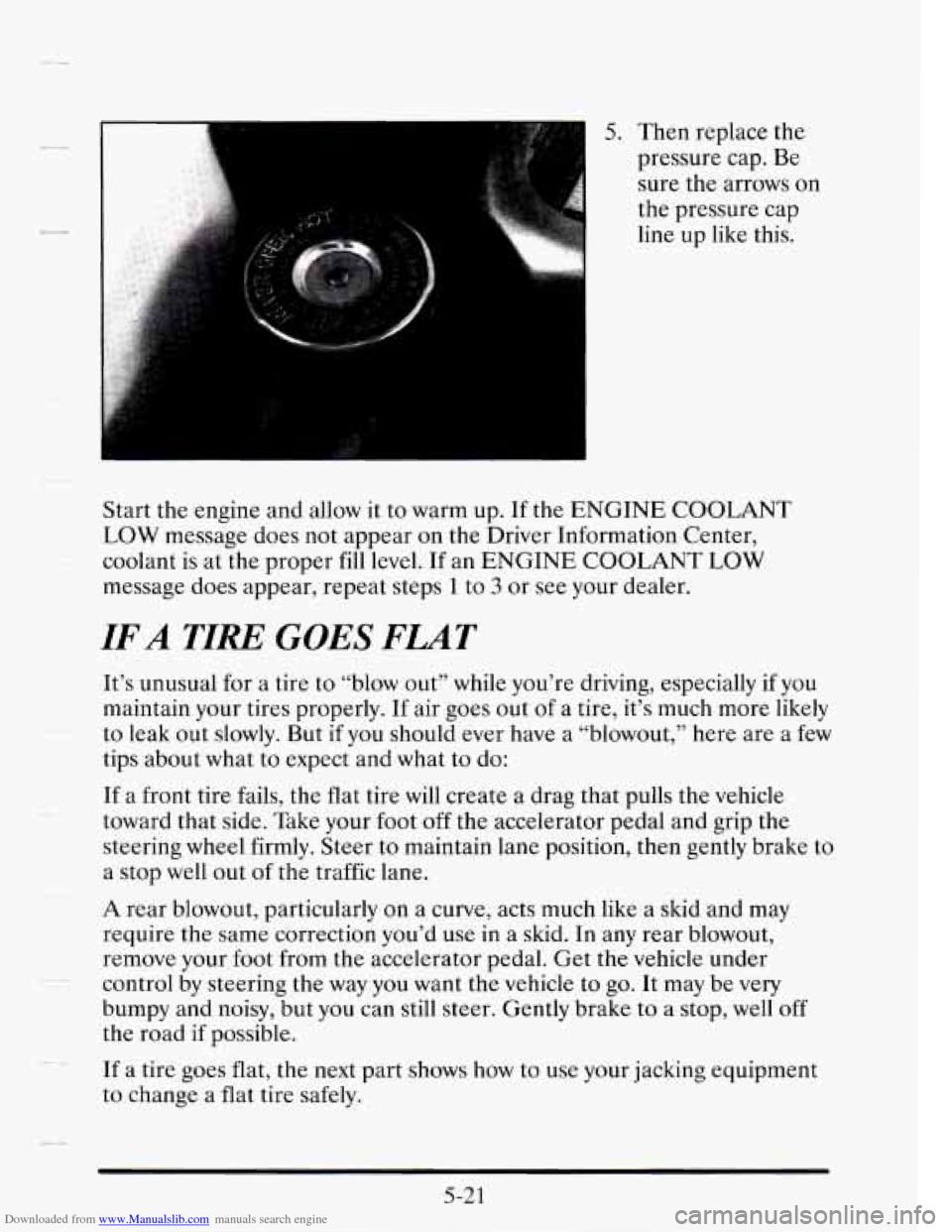
Downloaded from www.Manualslib.com manuals search engine 5. Then replace the
pressure
cap. Be
sure the arrows on
the pressure cap
line up
like this.
Start the engine and allow
it to warm up. If the ENGINE COOLANT
LOW message does not appear on the Driver Information Center,
coolant
is at the proper fill level. If an ENGINE COOLANT LOW
message does appear, repeat steps 1 to 3 or see your dealer.
IFA TIRE GOES FLAT
It’s unusual for a tire to “blow out” while you’re driving, especially if you
maintain your tires properly.
If air goes out of a tire, it’s much more likely
to leak out slowly. But if you should ever have a “blowout,” here are a few
tips about
what to expect and what to do:
If a front tire fails, the flat tire
will create a drag that pulls the vehicle
toward that side. Take your foot off the accelerator pedal and grip the
steering wheel firmly. Steer to maintain lane position, then gently brake to
a stop well out of the traffic lane.
A rear blowout, particularly on a curve, acts much like a skid and may
require the same correction you’d use in a skid. In any rear blowout,
remove your foot from the accelerator pedal. Get the vehicle under
control by steering the way you want the vehicle
to go. It may be very
bumpy and noisy, but you can still steer. Gently brake to a stop, well off
the road
if possible.
If
a tire goes flat, the next part shows how to use your jacking equipment
to change a flat tire safely.
5-2 1
Page 270 of 410
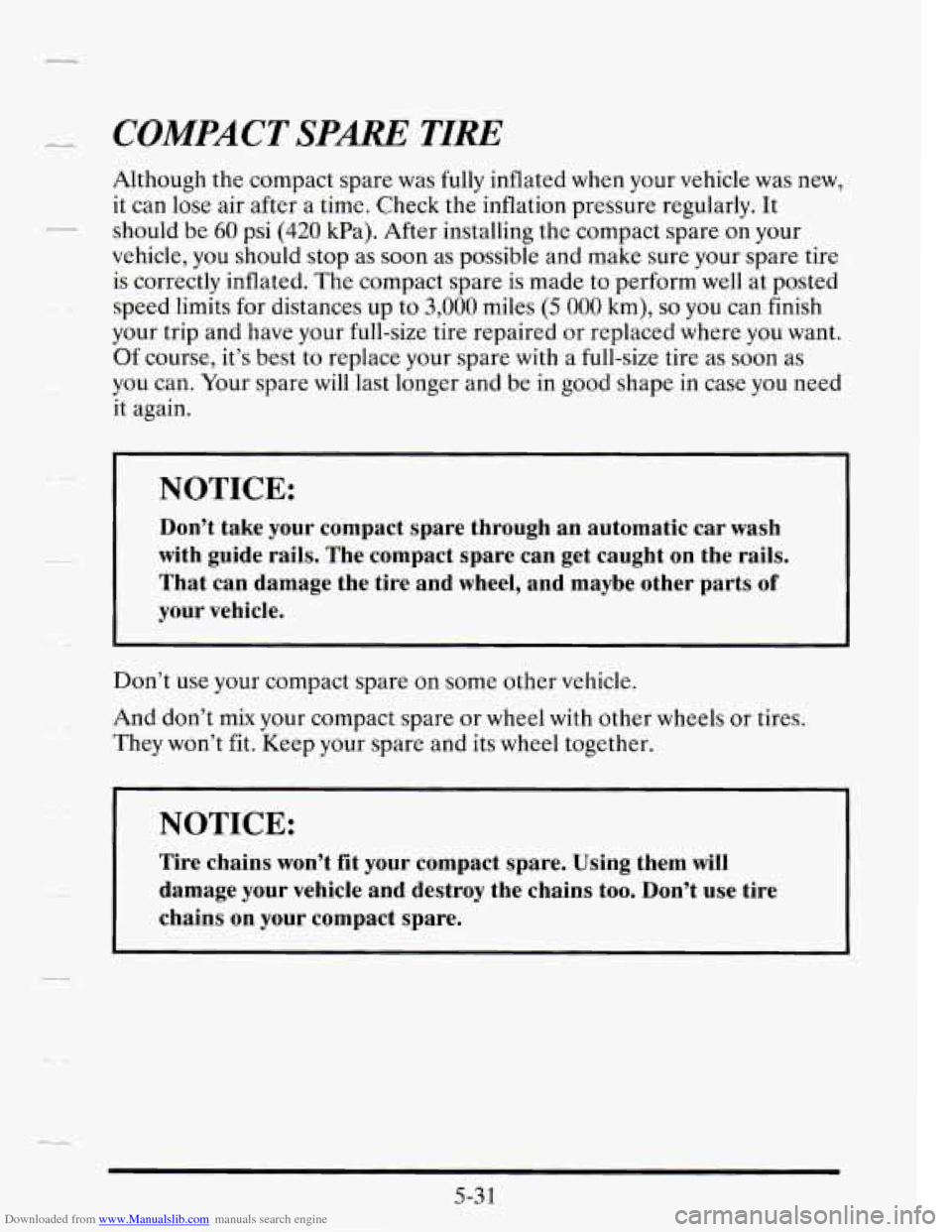
Downloaded from www.Manualslib.com manuals search engine COMPACT SPARE TIRE
Although the compact spare was fully inflated when your vehicle was new,
it can lose air after a time. Check the inflation pressure regularly. It
should be
60 psi (420 kPa). After installing the compact spare on your
vehicle, you should stop as soon as possible and make sure your spare tire
is correctly inflated. The compact spare
is made to perform well at posted
speed limits for distances up to
3,000 miles (5 000 km), so you can finish
your trip and have your full-size tire repaired
or replaced where you want.
Of course, it’s best to replace your spare
with a full-size tire as soon as
you can. Your spare will last longer and be
in good shape in case you need
it again.
1 NOTICE:
Don’t take your compact spare through an automatic car wash
with guide rails. The compact spare can get caught on the rails.
That can damage the tire and wheel, and maybe other parts
of
your vehicle.
Don’t use your compact spare on some other vehicle.
And don’t mix your compact spare or wheel with other wheels or tires.
They won’t fit. Keep your spare and its wheel together.
NOTICE:
Tire chains won’t fit your compact spare. Using them will
damage your vehicle and destroy the chains too. Don’t use tire
chains on your compact spare.
5-3 1
Page 271 of 410
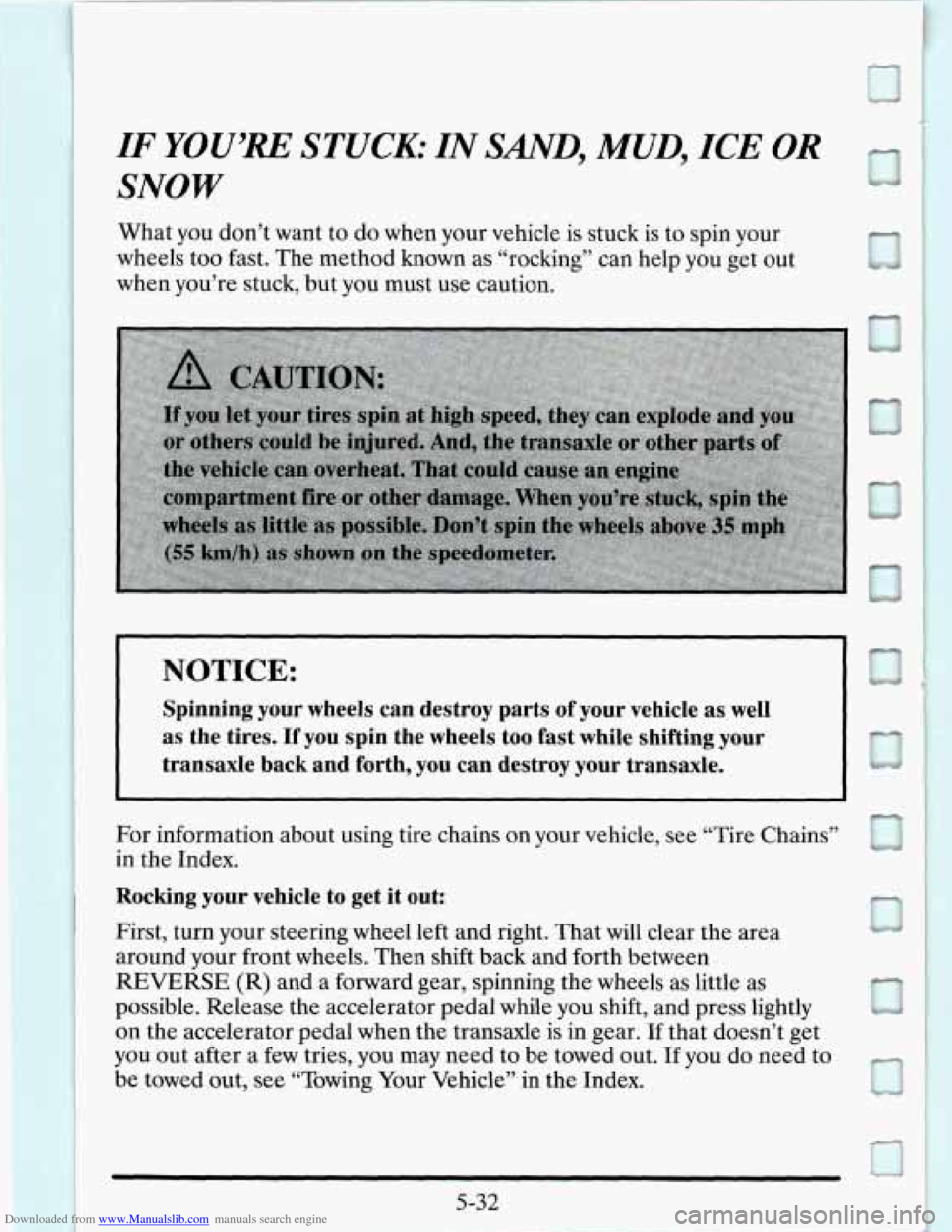
Downloaded from www.Manualslib.com manuals search engine IF YOU’RE STUCK: IN SAND, MUD, ICE OR
SNOW
What you don’t want to do when your vehicle is stuck is to spin your
wheels too fast. The method known as “rocking” can help you get out
when you’re stuck, but you must use caution.
NOTICE:
Spinning your wheels can destroy parts of your vehicle as well
as the tires. If you spin the wheels too fast while shifting your
transaxle back
and forth, you can destroy your transaxle.
For information about using tire chains on your vehicle, see “Tire Chains”
in the Index.
Rocking your vehicle to get it out:
First, turn your steering wheel left and right. That will clear the area
around your front wheels. Then shift back and forth between
REVERSE (R) and a forward gear, spinning the wheels as little as
possible. Release the accelerator pedal while you shift, and press lightly
on the accelerator pedal when the transaxle is in gear. If that doesn’t get
you out after
a few tries, you may need to be towed out. If you do need to
be towed out, see “Towing Your Vehicle” in the Index.
I
I
n U
5-32
Page 314 of 410
Downloaded from www.Manualslib.com manuals search engine TIRES
We don’t make tires. Your new vehicle comes with high-quality tires made
by a leading tire manufacturer.
If you ever have questions about your tire
warranty and where to obtain service, see
your Cadillac Warranty booklet
for details.
Page 315 of 410
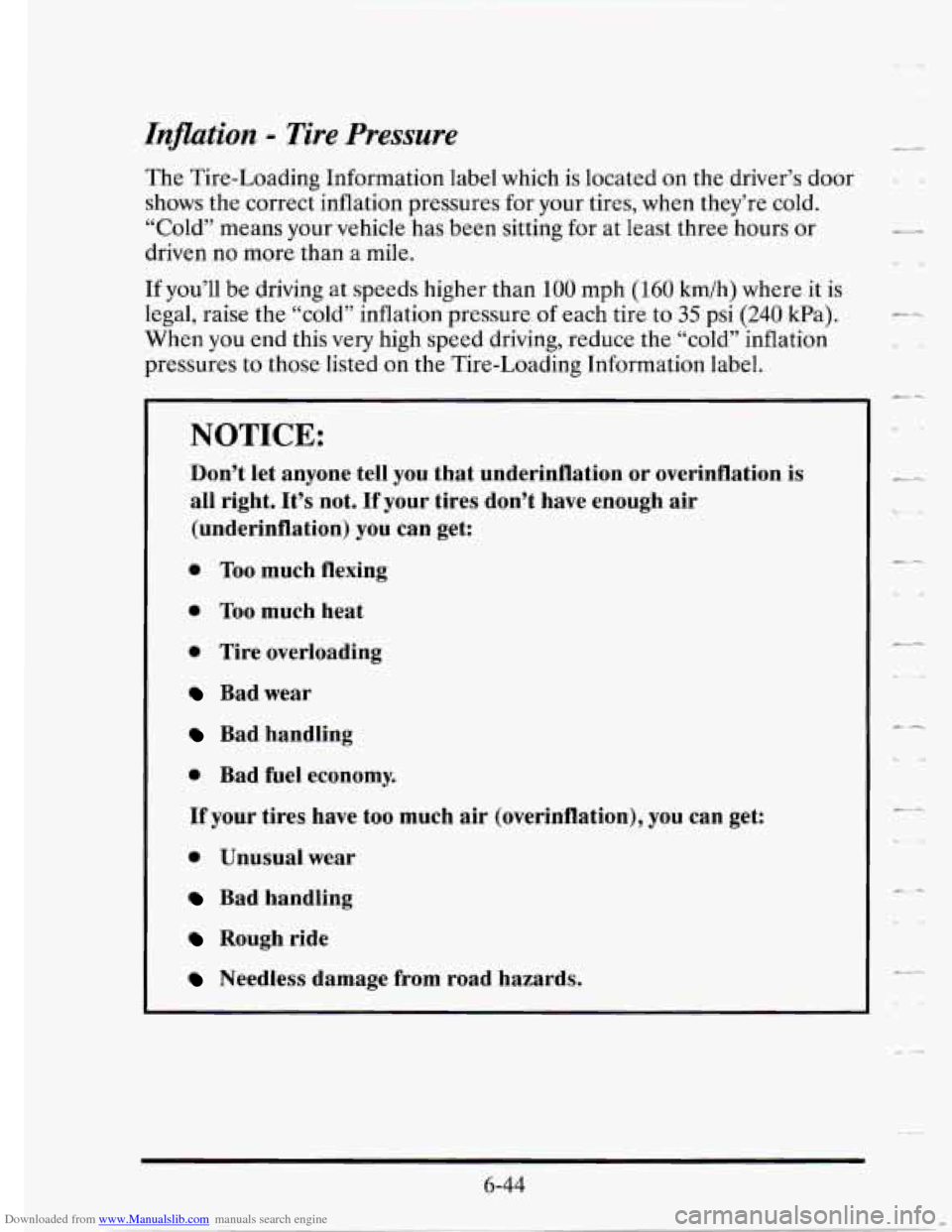
Downloaded from www.Manualslib.com manuals search engine Inflation - Tire Pressure
The Tire-Loading Information label which is located on the driver’s door
shows the correct inflation pressures for your tires, when they’re cold.
“Cold’’ means your vehicle has been sitting for at least three hours
or
driven no more than a mile.
If you’ll be driving at speeds higher than 100 mph (160 km/h) where it is
legal, raise the “cold” inflation pressure
of each tire to 35 psi (240 kPa).
When you end this very high speed driving, reduce the “cold” inflation
pressures to those listed on the Tire-Loading Information label.
NOTICE:
Don’t let anyone tell you that underinflation or overinflation is
all right. It’s not. If your tires don’t have enough air
(underinflation) you can get:
0 Too much flexing
0 Too much heat
0 Tire overloading
Bad wear
Bad handling
0 Bad fuel economy.
If your tires have too much air (overinflation), you can get:
0 Unusual wear
Bad handling
Rough ride
Needless damage from road hazards.
6-44
c-
---
I --
cy-
t4
L-
Page 316 of 410
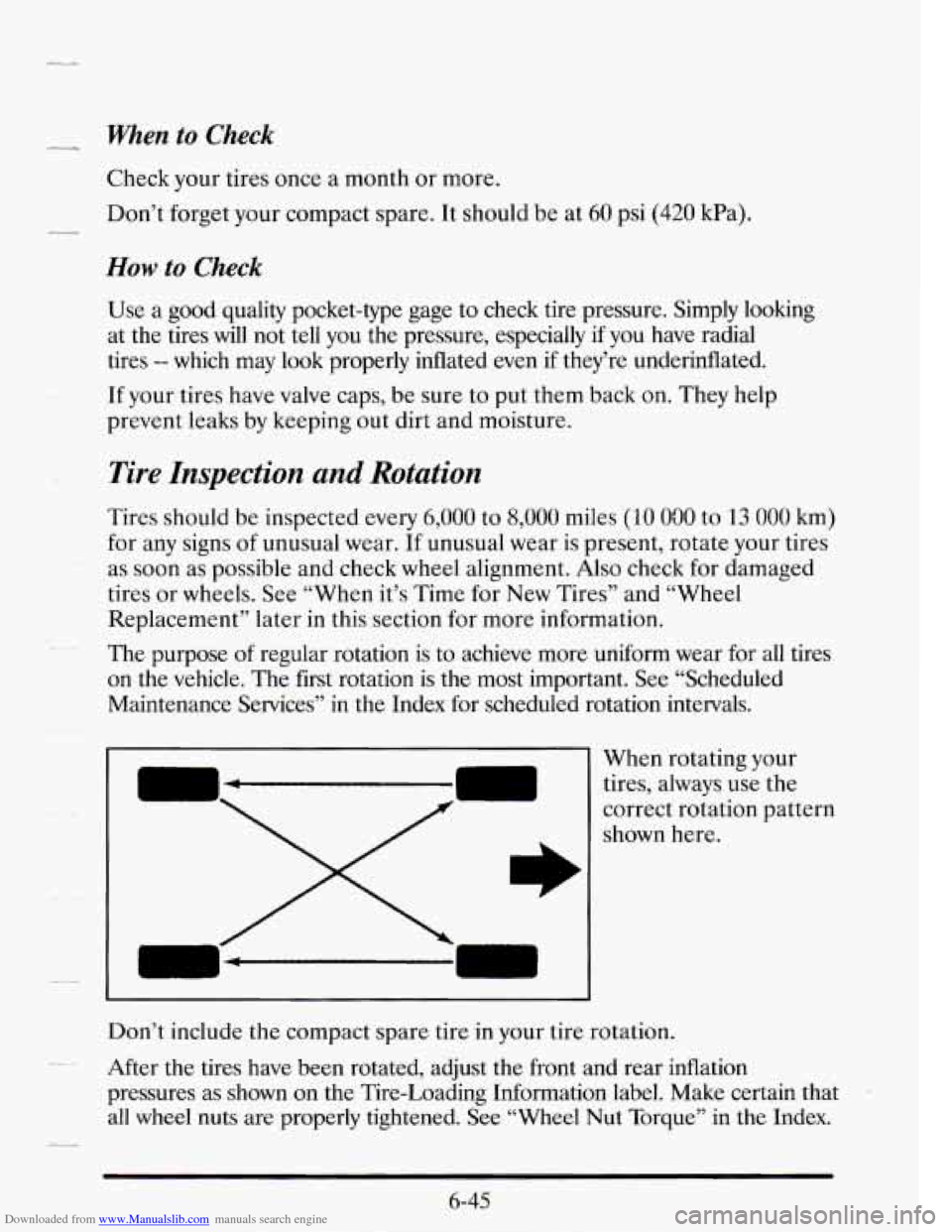
Downloaded from www.Manualslib.com manuals search engine When to Check
- -c
- --
c-
Check your tires once a month or more.
Don’t forget your compact spare. It should be at
60 psi (420 kPa).
How to Check
Use a good quality pocket-type gage to check tire pressure. Simply looking
at the tires will not tell you the pressure, especially if you have radial
tires
-- which may look properly inflated even if they’re underinflated.
If your tires have valve caps, be sure to put them back on. They help
prevent leaks by keeping out dirt and moisture.
Tire Inspection and Rotation
Tires should be inspected every 6,000 to 8,000 miles (10 030 to 13 000 km)
for any signs
of unusual wear. If unusual wear is present, rotate your tires
as
soon as possible and check wheel alignment. Also check for damaged
tires or wheels. See “When it’s Time for New Tires” and “Wheel
Replacement’’ later in this section
for more information.
The purpose of regular rotation is to achieve more uniform wear for all tires
on the vehicle. The first rotation is the most important. See “Scheduled
Maintenance Services” in the Index for scheduled rotation intervals.
When rotating your
tires, always use the
correct rotation pattern
shown here.
Don’t include the compact spare tire in your tire rotation.
After the tires have been rotated, adjust the front and rear inflation
pressures as shown
on the Tire-Loading Information label. Make certain that
all wheel nuts are properly tightened. See “Wheel
Nut Torque” in the Index.
6-45
Page 317 of 410
Downloaded from www.Manualslib.com manuals search engine When it 3 Time for New Tires
One way to tell when
it’s time for new tires is
to check the treadwear
indicators, which will
appear when your tires
have
only 1/16 inch
(1.6 mm) or less of
tread remaining.
You need a new tire
if
You can see the indicators at three or more places around the tire.
You can see cord or fabric showing through the tire’s rubber.
-
C.
*-
a The tread or sidewall is cracked, cut or snagged deep enough to show
cord or fabric.
6-46
-